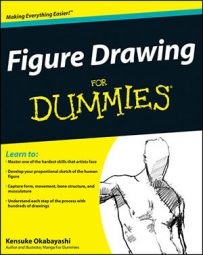Essential figure drawing supplies
You don’t have to feel overwhelmed when you walk into the art supplies store to buy your figure drawing materials. Remember to buy the supplies based on your budget and needs. (You can always buy more!) Arm yourself with this list of the basic supplies you need for figure drawing in a studio:
-
Drawing pad (18 x 24 inches)
-
Tracing paper
-
Drawing pencils
-
Soft vine charcoal
-
Markers
-
Kneaded and plastic erasers
-
Pencil sharpeners
-
X-Acto blades
-
Sandpaper
-
Rulers (straight edge and triangle)
-
A composition grid
-
Artists tape
-
Spray fixative
-
Drafting lamp
-
Drawing table
-
Drafting chair
-
Side table
-
Archival boxes and folders
-
Egg timer
Portable figure drawing studio items
Once in a while, step out of your art studio for a breath of fresh air. An occasional change of physical and psychological scenery is essential for figure drawing. Besides your figure drawing pad and tools, pack up the following supplies:
-
Drawing backboard with clip
-
Portfolio case
-
Carrying case for your drawing tools
-
Paper towels/baby wipes (for cleaning up after yourself)
-
Portable folding chair
-
Baseball cap
-
Water and snacks
-
Music player
-
Blanket
Great spots for studying and drawing the figure
Even the most motivated artist can benefit from outside education and another artist’s input to help with figure drawing. A variety of outside inspiration exists to help you create fresh figure drawing ideas and methods. Here are a few great places for studying and drawing the human form:
-
Continuing education classes and art schools
-
Open sessions at your local art institution
-
Art galleries and museums
-
Trains and other mass transportation
-
Bookstores and coffee shops
-
Libraries
-
Parks
-
Beaches
-
Shopping malls
-
Public squares
A simple way to draw the head
If you want to build your figure drawing confidence, put down the drawing tools and use the freehand method to draw the basic structure of the head. Just follow these basic steps:
-
Draw an oval shape that resembles an upside-down egg.
-
Draw a horizontal line and a vertical line to form a cross that divides the oval evenly.
-
Place two small circles along the horizontal guideline for the center of the eyes and lightly draw an arc above each circle; the width of the arc shouldn’t be more than one-fifth of the width of the head.
-
Draw a slightly larger arc above each eye to indicate the eyebrow; make sure that each arc slightly angles down toward the center of the guidelines.
-
Draw a small concave arc for the nose so that the bottom of the arc is about halfway between the horizontal guideline and the bottom of the chin; make the width of the arc about one eye width.
-
Indicate the mouth with a line halfway between the bottom of the nose and the bottom of the chin; place the line symmetrically along the vertical guideline.
-
Draw a C shape on each side of the head for each ear; the top of the ear shouldn’t go past the top of the eye and the bottom of the ear shouldn’t go past the nose.
-
Draw two short parallel lines for the neck, starting each line from the bottom of each C ear shape; the length of each line should be half of the length of the head.
Fixing figure drawing bloopers
Even the most experienced artists make mistakes in their work. Fortunately if you make a figure drawing mistake it doesn’t have to be completely removed to maintain the integrity of your drawing. Here are some clever techniques for fixing figure drawing bloopers:
-
Use a kneaded eraser (the advantage is that you have no eraser dust).
-
For correcting darker lines, use the end of a plastic eraser.
-
Rub out the mistakes by using a soft cloth.
-
Use your finger to smudge lighter blooper lines.
-
Use darker lines to trace over the lighter blooper lines without erasing.

